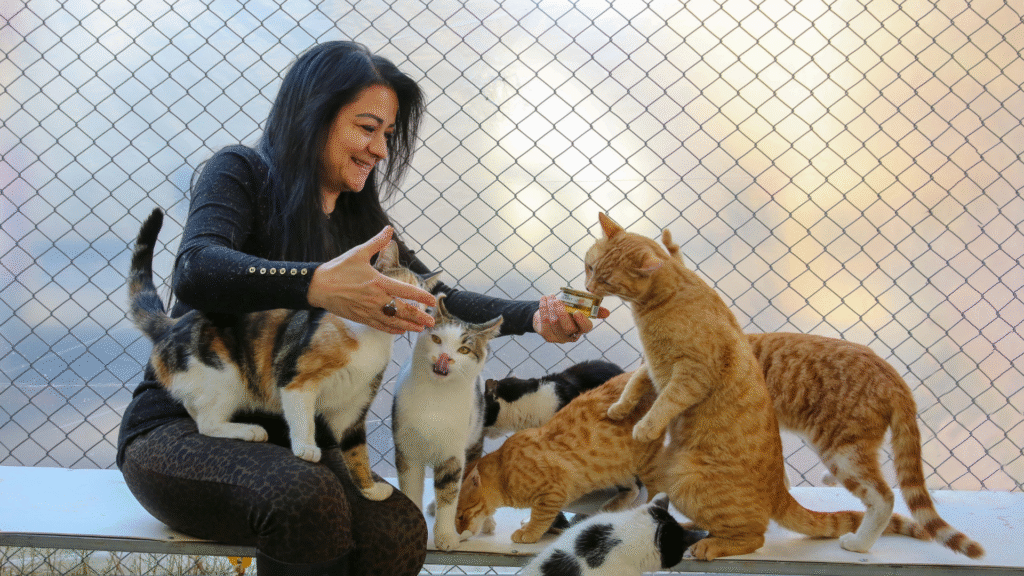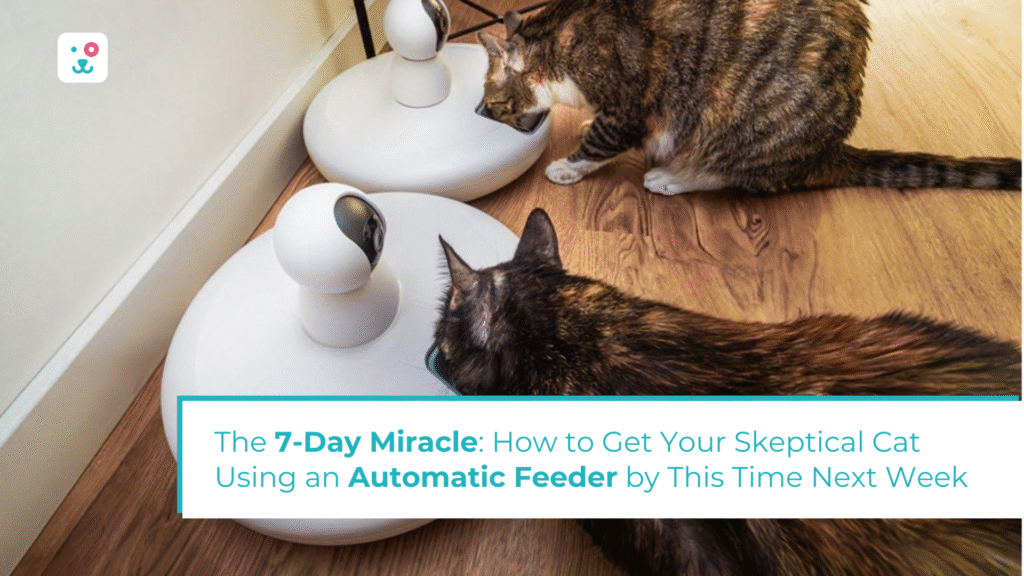That fancy automatic cat feeder you splurged on sits untouched in the corner while your cat gives it the cold shoulder. Sound familiar? Many pet parents find themselves with an expensive smart feeder gathering dust because their feline simply refuses to go near it.
Here’s the truth most pet blogs won’t tell you: cats rarely reject feeders because they’re “too picky” – they reject them because we rush the introduction.
With this systematic 7-day approach, even the most suspicious cats can learn to embrace automated feeding. The secret isn’t forcing technology on your cat; it’s making the technology feel like their idea.
Cats don’t fear change. They fear loss of control.
Before Day 1: Setting Your Automatic Cat Feeder Up for Success
Before your cat even sees the automatic food dispenser, proper preparation significantly impacts success. Choose a model that matches your cat’s personality – jumpy cats do better with quieter models like the whisper-quiet options, while food-obsessed cats need sturdier models with anti-tampering features.
Unbox and assemble your automatic pet feeder in a separate room, away from curious eyes. This prevents your cat from associating any frustration during setup with the feeder itself.
Location matters more than most pet parents realize. The ideal spot is:
- Semi-private but not isolated
- Away from high-traffic areas that make cats feel vulnerable
- Not backed against a wall where they might feel cornered
- Consistent with their existing territorial comfort zones
Counter Insight: Many guides suggest placing the feeder exactly where their old bowl was. This actually creates more confusion and resistance, as cats notice the “wrong” object in a familiar place. A nearby but slightly different location often works better.
Gather these transition tools: your cat’s current food bowl, their regular food, and treats they rarely get but absolutely love.
Day 1: The Silent Observer Phase
Today’s goal is deceptively simple: let your cat discover the unplugged automatic cat feeder on their terms.
Set the feeder down nearby — not too close — and just let it sit there like it’s no big deal. Continue feeding your cat normally in their regular bowl, making no fuss about the new device. Watch their reaction from a distance – curious sniffing is excellent, while complete avoidance is normal too.
What matters isn’t their immediate interest, but that they eat comfortably with the feeder in the vicinity.
Counter Insight: Some pet parents mistake initial fear for permanent rejection. In reality, cats who seem the most suspicious on day one often adapt faster once they’ve had time to investigate on their terms.
Success for day one is simple: your cat ate their normal meal with the automatic feeder nearby. That’s it!
Day 2: The Familiar Bowl Transfer
Today we leverage your cat’s existing trust in their food bowl to build a bridge to the new technology.
Take your cat’s familiar food bowl and place it directly beside or even on top of the automatic pet feeder (if design allows). Continue hand-feeding as normal, but now they’re associating positive experiences with the general vicinity of this strange new object.
Between meals, place a few high-value treats around (not in) the automatic feeder. This encourages investigation without any mechanical surprises.
For some particularly independent cats, using their existing bowl slows acceptance. These cats sometimes prefer a clean break – a new bowl with a new device – rather than a confusing hybrid of familiar and unfamiliar.
Watch for increased comfort approaching the area. Even if they grab treats quickly and retreat, that’s progress worth celebrating.
Day 3: Building the Reward Connection
Today’s mission: help your cat associate the automatic pet feeder with unexpected bonuses, not just their regular meals.
Place their regular food bowl even closer to the feeder (or on it if possible). After they eat comfortably, manually trigger the feeder to dispense a few pieces of kibble or a small treat onto a plate beside it. Don’t force them to eat from the feeder itself yet – we’re just creating positive associations with its functioning.
The sequence matters: normal meal first, then the feeder provides bonus treats. This prevents hunger from creating negative pressure.
While food rewards work for most cats, approximately 15% of cats are more motivated by play or attention than food. For these cats, follow feeding with an interactive toy session near the feeder.
By day’s end, your cat should be showing genuine curiosity about this device that mysteriously produces extra goodies.
Day 4: Sound Introduction Techniques for Your Automatic Feeder
The mechanical sounds of an automatic cat feeder cause more transition failures than any other factor. Today we tackle this challenge methodically.
Choose a moment when your cat is relaxed but not sleeping. From a distance, activate the empty smart pet feeder so they hear the operating sounds without the pressure of having to eat. Watch their reaction – some startling is normal, but they should recover quickly.
Gradually decrease distance between your cat and the operating feeder over several trials, always following the sound with a positive experience (treats, petting, or play).
If your cat shows significant fear:
- Place a towel under the feeder to dampen vibration
- Start with the feeder in a different room, gradually moving closer
- Use the “night mode” or “quiet mode” if your model offers it
While most advice focuses on minimizing feeder noise, some cats prefer louder, consistent mechanical sounds over unpredictable quiet ones. These cats often adapt better to feeders with distinct but consistent operating noises.
Success today means your cat can remain calm in the room while the feeder operates, even if they don’t approach it immediately.
Day 5: The First Automated Meal from Your Smart Feeder
Today’s milestone: your cat’s first actual meal dispensed by the automatic feeder.
Program the timed pet feeder to release a small portion (about 25% of their normal meal). Stay present and supplement with hand-fed food immediately afterward. This creates a clear association: the mechanical sound leads to food appearing, which is then followed by more food from you.
Some cats may hesitate at first – allow them to approach on their terms without hovering or showing anxiety. Your calm presence provides reassurance that this new feeding method is safe and normal.
While conventional wisdom suggests staying nearby for reassurance, approximately 20% of cats adapt faster when left alone with the automatic feeder. These independent cats feel less performance pressure without an audience.
By day’s end, your goal is for your cat to at least investigate the food dispensed by the machine, even if they don’t eat a full meal from it yet.
Day 6: Increasing Automatic Feeding Comfort
Now we build on yesterday’s progress by expanding to multiple automated meals while gradually reducing your hovering presence.
Set the automatic cat feeder to dispense a larger portion (50-75% of a normal meal) and gradually increase your distance during feeding. Start by stepping back a few feet, then briefly leaving the room before returning.
Monitor consumption carefully – many cats eat more readily from automatic feeders when they have privacy.
Counter Insight: While the goal is fully automated feeding, maintaining occasional manual feeding (perhaps one meal per week) improves overall acceptance. This hybrid approach preserves the bonding experience while still providing the convenience of automation.
Success today means your cat approaches and eats from the automatic pet feeder with minimal hesitation, even if you’re not directly beside them.
Day 7: Full Transition to Your Automatic Pet Feeder
The final milestone: complete meals delivered by your automatic cat feeder with you entirely removed from the feeding process.
Program the smart pet feeder with your cat’s full regular schedule. Monitor initially through any available camera features or by casually observing from a distance. Resist the urge to hover or check constantly – your confidence in the system helps your cat feel secure.
True success extends beyond just eating – look for relaxed body language before, during, and after the automatic feeding. A content cat will often groom after eating, indicating comfort with their new routine.
Counter Insight: Don’t mistake partial adaptation for failure. Some cats may always prefer to eat while you’re home, while happily using the automatic feeder when you’re away. This selective usage still achieves the primary goal of reliable feeding during your absence.
Also Read: Why Do Vets Recommend the Use of Cat Water Fountains?
Beyond Week One: Solving Persistent Automatic Feeder Challenges
If your cat still shows resistance after seven days, consider these specialized approaches:
For extremely cautious cats:
- Extend the transition timeline, spending 2-3 days on each step
- Try a different model with quieter operation or different dispensing mechanism
- Consider feeder placement from a “cat confidence” perspective (elevated positions often work better)
For multi-cat households:
- Microchip pet feeders that only open for specific cats eliminate competition anxiety
- Separate feeding stations reduce territorial tension
- Staggered feeding times prevent resource guarding
Counter Insight: While most feeding issues resolve with proper introduction, some reflect deeper anxiety that might benefit from feline pheromone products placed near the feeder or consultation with a veterinary behaviorist.

The Freedom of Successful Automatic Cat Feeding
A properly introduced automatic cat feeder transforms your relationship with your pet. No more pre-dawn wake-up calls or rushing home for dinner time – just the peace of mind knowing your cat is fed consistently whether you’re stuck in traffic or away for the weekend.
The time invested in this seven-day transition pays dividends in reliability and reduced stress for years to come.
Cats don’t resist technology. They resist change that feels forced upon them.
Give them the dignity of choice, and they’ll surprise you with their adaptability.

